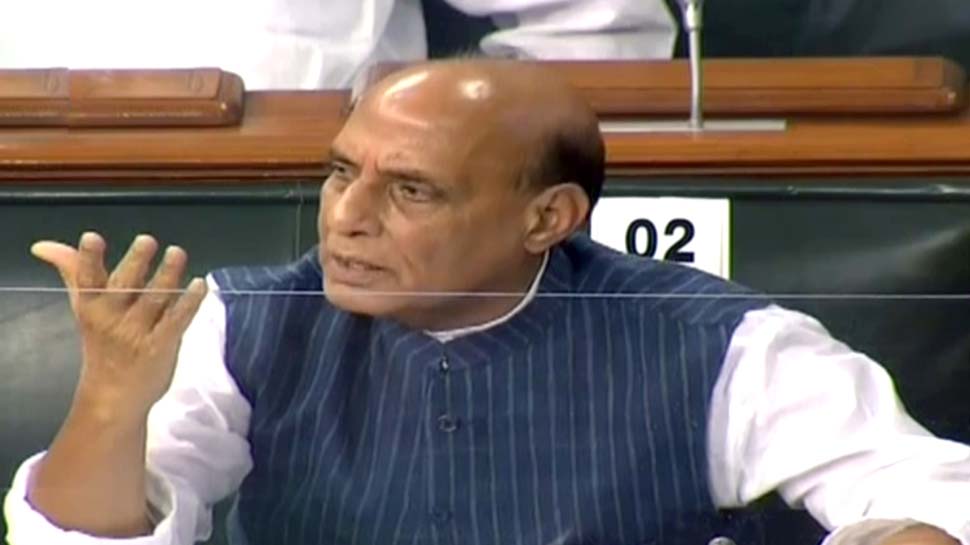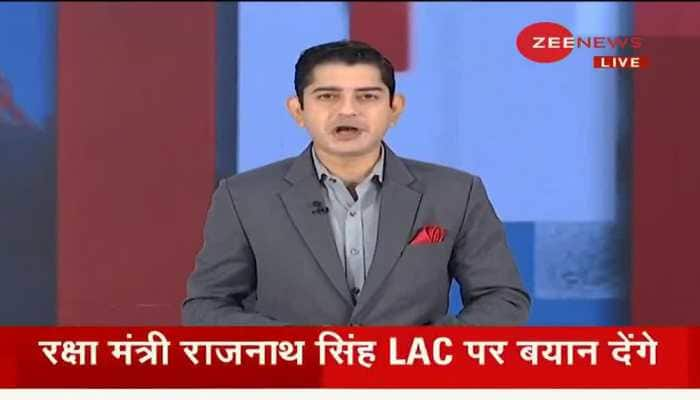China has mobilised a large number of troops and armaments along the Line of Actual Control (LAC) asserted Union Defence Minister Rajnath Singh on Tuesday, adding that the Indian armed forces have made adequate counter deployments in response to China`s actions.
READ | China in unauthorized occupation of about 38,000 square km of land in Ladakh: Rajnath Singh | Full text of Defence Minister
Making a statement in Lok Sabha, he added that the House should have full confidence that Indian armed forces will always rise to the challenge. Singh stated that this is still an ongoing situation and involves sensitive operational issues.
"As of now, the Chinese side has mobilized a large number of troops and armaments along the LAC as well as in the depth areas. There are several friction areas in Eastern Ladakh including Gogra, Kongka La and North and South Banks of the Pangong Lake. In response to China’s actions, our armed forces have also made appropriate counter deployments in these areas to ensure that India’s security interests are fully protected," he said.
"The House should have full confidence that our armed forces will always rise to the challenge and do us all proud. This is still an ongoing situation and obviously involves sensitive operational issues. I would, therefore, not be able to give more details in public and I am confident about the understanding of the House in this regard," he added.
Here are the key points:
* I would like to take some time first to briefly provide some details of our boundary issue with China. As the House is aware, India and China are yet to resolve their boundary question. China does not accept the customary and traditional alignment of the boundary between India and China. We believe that this alignment is based on well-established geographical principles confirmed by treaties and agreements, as well as historical usage and practice, well-known for centuries to both sides. The Chinese position, however, is that the boundary between the two countries has not been formally delimited, that there exists a traditional customary line formed by the extent of jurisdiction that they claim was exercised historically by each side, and that the two sides have different interpretations of the position of the traditional customary line. The two countries had engaged in discussions during 1950s-60s but these efforts could not yield a mutually acceptable solution.
* As the House is aware, China continues to be in illegal occupation of approximately 38,000 sq. km in the Union Territory of Ladakh. In addition, under the so-called Sino-Pakistan 'Boundary Agreement' of 1963, Pakistan illegally ceded 5,180 sq. km. of Indian territory in Pakistan Occupied Kashmir to China. China also claims approximately 90,000 sq. km. of Indian territory in the Eastern Sector of the India-China boundary in Arunachal Pradesh.
* The Government has an elaborate and time tested coordination mechanism amongst different intelligence agencies including intelligence units of the Central Police Forces and the three armed forces. Technical and human intelligence is continuously gathered in a well-coordinated manner. It is shared with the armed forces which help them in taking decisions.
* Since April, we had noticed a buildup of troops and armaments by the Chinese side in the border areas adjacent to Eastern Ladakh. In early May, the Chinese side had taken action to hinder the normal, traditional patrolling pattern of our troops in the Galwan Valley area, which resulted in a face-off. Even as this situation was being addressed by the Ground Commanders as per the provisions of our bilateral agreements and protocol, in mid-May the Chinese side made several attempts to transgress the LAC in other parts of the Western Sector. This included Kongka La, Gogra and North Bank of Pangong Lake. These attempts were detected early and consequently responded to appropriately by our armed forces.
* We made it clear to the Chinese side both through diplomatic and military channels that China was, by such actions, attempting to unilaterally alter the status quo. It was categorically conveyed that this was unacceptable.
* India believes that mutual respect and mutual sensitivity are the basis for peaceful relations with neighbours. As we want to resolve the current situation through dialogue, we have maintained diplomatic and military engagement with the Chinese side. In these discussions, we have maintained the three key principles that, determine our approach: (i) both sides should strictly respect and observe the LAC; (ii) neither side should attempt to alter the status quo unilaterally; and (iii) all agreements and understandings between the two sides much be fully abided by in their entirety. The Chinese side, on its part, took the position that the situation should be handled in a responsible manner and ensure peace and tranquillity as per bilateral agreements and protocol.
* Even as these discussions were going on, the Chinese side again engaged in provocative military manoeuvers on the night of 29thand 30th August in an attempt to change the status quo in the South Bank area of Pangong Lake. But yet again, timely and firm actions by our armed forces along the LAC prevented such attempts from succeeding.
* The Chinese actions reflect a disregard of our various bilateral agreements. The amassing of the troops by China goes against the 1993 and 1996 Agreements. Respecting and strictly observing the Line of Actual Control is the basis for peace and tranquillity in the border areas and explicitly recognized in both 1993 and 1996 agreements. While our armed forces abide scrupulously by it, this has not been reciprocated by the Chinese side. Their actions have led to face-offs and frictions from time to time along the LAC. As I mentioned earlier, the agreements have detailed procedures and norms to deal with the situation of face-offs. However, in the recent incidents, this year, the violent conduct of Chinese forces has been in complete violation of all mutually agreed norms.
* As of now, the Chinese side has mobilized a large number of troops and armaments along the LAC as well as in the depth areas. There are several friction areas in Eastern Ladakh including Gogra, Kongka La and North and South Banks of the Pangong Lake. In response to China’s actions, our armed forces have also made appropriate counter deployments in these areas to ensure that India’s security interests are fully protected. The House should have full confidence that our armed forces will always rise to the challenge and do us all proud. This is still an ongoing situation and obviously involves sensitive operational issues. I would, therefore, not be able to give more details in public and I am confident about the understanding of the House in this regard.
* This rapid deployment by our armed forces including ITBP has taken place in a challenging time of COVID-19. Their efforts need to be appreciated. It has also been made possible by the high importance that the Government has placed for developing border infrastructure in the last few years. The House is aware that over the last many decades, China had undertaken significant infrastructure construction activity that enhanced its deployment capabilities in the border areas. However, in response, our Government too has stepped up the budget for border infrastructure development to about double the previous levels. As a result, more roads and bridges have been completed in the border areas. This has not only provided much-needed connectivity to the local population but has also provided better logistical support for our armed forces, enabling them to be more alert in the border areas and respond more effectively where required. In the coming years too, the Government remains committed to this objective.
* India remains committed to resolving the current issues in our border areas through peaceful dialogue and consultations. It was in pursuit of this objective that I met my Chinese counterpart on 4th September in Moscow and had an in-depth discussion with him. I conveyed in clear terms our concerns related to the actions of the Chinese side, including amassing of a large number of troops, their aggressive behaviour and attempts to unilaterally alter the status quo that were in violation of the bilateral agreements. I also made it clear that even as we wanted to peacefully resolve the issue and would like the Chinese side to work with us, there should also be no doubt about our determination to protect India’s sovereignty and territorial integrity. My colleague, Shri Jai Shankar, the External Affairs Minister, has thereafter met the Chinese Foreign Minister in Moscow on 10th September. The two have reached an agreement that, if implemented sincerely and faithfully by the Chinese side, could lead to complete disengagement and restoration of peace and tranquillity in the border areas.
* I will not hesitate to share with this august House that we are facing a challenge in Ladakh and I urge the House to pass a resolution in support of our Armed Forces who have been defending our motherland at great heights and most inclement weather conditions in Ladakh for our safety and security


















